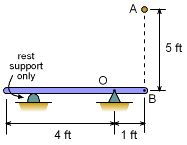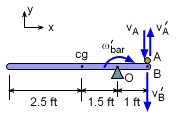| Ch 8. Rigid Body Momentum/Impulse | Multimedia Engineering Dynamics | ||||||
| Impulse Momentum | Eccentric Impact | ||||||
| Eccentric Impact of Rigid Bodies | Case Intro | Theory | Case Solution | Example |
| Chapter |
| - Particle - |
| 1. General Motion |
| 2. Force & Accel. |
| 3. Energy |
| 4. Momentum |
| - Rigid Body - |
| 5. General Motion |
| 6. Force & Accel. |
| 7. Energy |
| 8. Momentum |
| 9. 3-D Motion |
| 10. Vibrations |
| Appendix |
| Basic Math |
| Units |
| Basic Dynamics Eqs |
| Sections |
| eBooks |
| Dynamics |
| Fluids |
| Math |
| Mechanics |
| Statics |
| Thermodynamics |
| ©Kurt Gramoll |
|
|
||
 Rod Impact |
Example |
|
|
A slender bar, B, has a mass of 2 slugs and is pinned at O. A 2 slug particle, A, is dropped from a height of 5 ft and strikes the bar at the far right end. What is the angular velocity of the bar just after impact? Assume the coefficient of restitution, e, is 1. |
||
| Solution |
||
|
|
First, find the velocity of the particle just before it strikes the bar. From conservation of energy, However, the linear velocity of B is related to the angular velocity of the bar, Combining gives, The angular momentum of the bar (with the particle attached) must be conserved, giving,
Mass moment of inertia, Io ω'B = 6.729 rad/s |
|
Practice Homework and Test problems now available in the 'Eng Dynamics' mobile app
Includes over 400 free problems with complete detailed solutions.
Available at the Google Play Store and Apple App Store.
